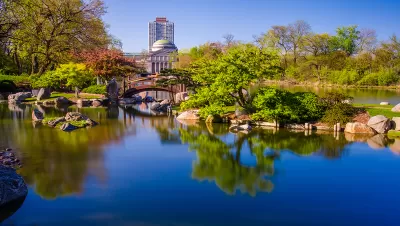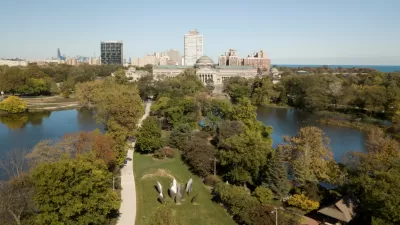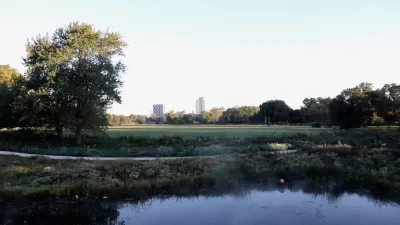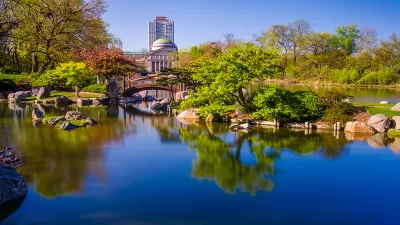Architects will soon be hired to design Obama's presidential library in Chicago. It may turn out to be a beautiful building, but will it be worth all that is lost in the process?

While the political world is being held captive by a 2016 election that continues to cycle between the vaguely amusing and the downright horrifying, our current president seems to be keeping a watchful eye toward his legacy. According to reports, he and the First Lady are evaluating a narrowed-down list of seven potential architectural firms to design the Barack Obama Presidential Center—the building that will house the artifacts from his terms in office and honor his life and achievements. As with all presidential libraries, this has to be one of the most coveted design commissions anywhere in the world. The final decision for selecting both the architect and the site for the building is expected in the near future.
None of this is breaking news; but it is still worth talking about. The project has attracted a ton of attention over the past year, largely due to the proposed sites inside either Washington Park or Jackson Park—both famous places located on the South Side of Chicago and products of the renowned landscape architect Frederick Law Olmsted and, at different stages, Calvert Vaux, Charles Eliot and John Charles Olmsted. Supporters of this hail the potential for such a building to revitalize neighborhoods, while detractors lament what would be the loss of over 20 acres of parkland that has significant cultural and historic value. While city administrators have claimed they understand the depth of the issue, the decision to put the building in one of the parks was likely never really in question. In situations like this, the landscape rarely stands much of a chance.

Chicago has been doing a lot right in its public realm lately, with beautiful new urban spaces and exciting projects repurposing aged infrastructure. These successes, however, may soon be tarnished by this latest proposal, which basically makes the statement, whether intended or not, that public open space is an expendable commodity subject to the whims of the ever-powerful real estate market. It certainly could be argued that this is a very special situation—Leader of the Free World and all that—but it still risks setting a dangerous precedent. Once people buy into the mindset, even a little bit, that open space is merely empty space waiting to be developed, there is really no turning back.
If this is all a done deal, and that certainly seems to be the case, then one can only hope it is handled in the best way possible moving forward. I actually do believe a well-designed building could be inserted into either park without doing too much aesthetic damage (note that I said could and not should). The Metropolitan Museum of Art did not show up on Olmsted and Vaux's Greensward Plan, but it would be hard to argue its presence in any way has destroyed New York City's Central Park. Sure, it can be done; it just goes back to the precedent thing—if this, then what else? Open space is either sacred or its not, there's not a lot of gray area in between.
Here's what I think needs to happen: Put the process to hire an architect on hold for now. They are all good firms, so no need to revisit the list. Just let them sit and wait for a while. In the meantime, select a landscape architect to evaluate the situation and determine the best site for the building—using Olmsted's designs as a starting point—and then set the design parameters for the selected architect to work from. In a sensitive situation such as this, where the value of the landscape is of such importance, having the architect determine the site for his or her building seems to me a conflict of interest.
I have worked with enough architects to know that, even despite their best intentions and noble assertions otherwise, they, by training, really just care about showing off their buildings to best advantage. Maybe that is understandable, but, by doing that, the landscape is inevitably reduced to being merely the setting for something deemed by the process to be more important. That shouldn't be allowed to happen here. A landscape architect steeped in the knowledge of Olmsted and cultural landscapes should determine how to maximize the project site and then manage the design process (including the architect) from then on.
Of course that won't happen.
My frustration with all of this results from the realization that not everyone is able to see what is so obvious to me—that urban landscapes have immense intrinsic value and are not just vacant spaces waiting to be cut and pasted to meet various agendas. I understand that we live in a democratic society filled with many constituencies and have to make compromises and concessions, but we need to be starting with a level playing field. It can't always be just about the buildings.
The importance of open spaces such as Jackson Park and Washington Park goes way beyond a calculation of their acreage. The problem is that effectively articulating this importance is not as easy as it should be. People love landscapes, and develop emotional connections with them, but it is hard to effectively quantify their value in ways that politicians can understand and respect. We are constantly seeing new data that point to the health and economic benefits provided by parks in cities, but it is just not making it into the public conversation…yet.
In the meantime, we are stuck with the mistaken assumption that open space is not worth fighting for. If we can't even save the integrity of a famous, cherished Olmsted park, what chance do we have of making people see just how much this matters?

Alabama: Trump Terminates Settlements for Black Communities Harmed By Raw Sewage
Trump deemed the landmark civil rights agreement “illegal DEI and environmental justice policy.”

Study: Maui’s Plan to Convert Vacation Rentals to Long-Term Housing Could Cause Nearly $1 Billion Economic Loss
The plan would reduce visitor accommodation by 25% resulting in 1,900 jobs lost.

Why Should We Subsidize Public Transportation?
Many public transit agencies face financial stress due to rising costs, declining fare revenue, and declining subsidies. Transit advocates must provide a strong business case for increasing public transit funding.

Paris Bike Boom Leads to Steep Drop in Air Pollution
The French city’s air quality has improved dramatically in the past 20 years, coinciding with a growth in cycling.

Why Housing Costs More to Build in California Than in Texas
Hard costs like labor and materials combined with ‘soft’ costs such as permitting make building in the San Francisco Bay Area almost three times as costly as in Texas cities.

San Diego County Sees a Rise in Urban Coyotes
San Diego County experiences a rise in urban coyotes, as sightings become prevalent throughout its urban neighbourhoods and surrounding areas.
Urban Design for Planners 1: Software Tools
This six-course series explores essential urban design concepts using open source software and equips planners with the tools they need to participate fully in the urban design process.
Planning for Universal Design
Learn the tools for implementing Universal Design in planning regulations.
Smith Gee Studio
Alamo Area Metropolitan Planning Organization
City of Santa Clarita
Institute for Housing and Urban Development Studies (IHS)
City of Grandview
Harvard GSD Executive Education
Toledo-Lucas County Plan Commissions
Salt Lake City
NYU Wagner Graduate School of Public Service






























